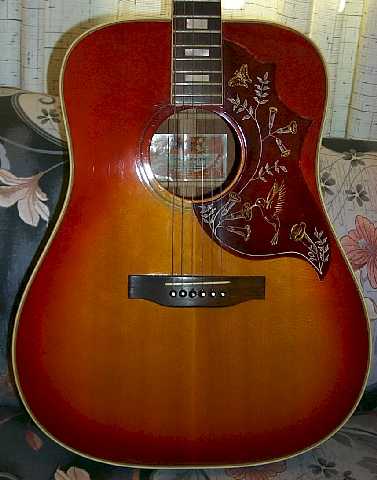
acoustic guitar for beginners tips image

Dawn
I would like to learn how to play the acoustic guitar, but reading music is so complicated. Are there any tips to learn how to play the guitar at a slow (but suceeding) pace, and the best way to learn how to read music from books?
Answer
1. Find a qualified guitar instructor and buy a beginner's guitar chord book having basic music theory.
2. Have your instructor show the good habits to form in building chords and playing them, how to string a guitar, how to take care of your instrument, and how to tune it.
3. As you learn and practice forming various chords ask your instructor to teach you the basics of music theory.
4. As you progress, ask the instructor to help you in:
a. Chord progression
b. Key transposition
c. How to determine the key signatures in music.
d. Writing basic music notation.
e. Playing rhythm as he plays melodies and vice versa.
f. Learning the Chromatic Scale with chords and notes.
5. Practice rhythm and strumming techniques--both striking the fundamental bass tone and strumming down and then back up. Practice fingerstyle methods of right picking different strings in chord backup.
6. Keep your instrument clean and in good shape. Treat it better than you would your own body. Keep your hands clean and dry while playing. That cuts back on oily residues.
7. Watch other guitarists and their technique or style. Copy their methods up to the point of forming your own style.
And finally, your fingertips will hurt terribly until you can build the calluses on them. Until then, you must endure hours of practice. If you don't have the motivation and strong will to work past the problem of sore fingertips you will never be a guitarist
1. Find a qualified guitar instructor and buy a beginner's guitar chord book having basic music theory.
2. Have your instructor show the good habits to form in building chords and playing them, how to string a guitar, how to take care of your instrument, and how to tune it.
3. As you learn and practice forming various chords ask your instructor to teach you the basics of music theory.
4. As you progress, ask the instructor to help you in:
a. Chord progression
b. Key transposition
c. How to determine the key signatures in music.
d. Writing basic music notation.
e. Playing rhythm as he plays melodies and vice versa.
f. Learning the Chromatic Scale with chords and notes.
5. Practice rhythm and strumming techniques--both striking the fundamental bass tone and strumming down and then back up. Practice fingerstyle methods of right picking different strings in chord backup.
6. Keep your instrument clean and in good shape. Treat it better than you would your own body. Keep your hands clean and dry while playing. That cuts back on oily residues.
7. Watch other guitarists and their technique or style. Copy their methods up to the point of forming your own style.
And finally, your fingertips will hurt terribly until you can build the calluses on them. Until then, you must endure hours of practice. If you don't have the motivation and strong will to work past the problem of sore fingertips you will never be a guitarist
What acoustic guitar brand should i get for a beginner and price range?

Missinthec
i was thinking an acoustic guitar, maybe black.
would yamaha be a good brand for beginners?
i don't know much about guitars, and what price range should it be in? i heard that you shouldn't get one too cheap. so im not sure.
Thanks for helping!
Answer
I could name you brands of guitars I've heard, and brands I've played, and brands I like, but it wouldn't make a difference. Instead of telling you which brand is king, here are some tips:
Honestly, my best advice is to go to your guitar shop and look at the brands. You can go online to get one, but it's a hit or miss when talking about how you'll like the sound and the feel.
Type: If you're a beginner, I would go for a nylon string guitar, as a nylon string guitar is easier on your fingers. The first guitar I played was on a Yamaha classical guitar, so I think Yamaha's are great. But I wouldn't say only get the Yamaha, because there might be a better guitar you find there.
Price range: Below $500. I wouldn't say you need a minimum, as long as you don't get the "Learn guitar in whatever kit" with the cheap ass acoustic the size of a breadbox at Barnes & Noble, but probably not under $100 (unless it seems legit. If you can't tell, probably don't get it).
Size: Find a guitar that you like at the shop, based on the size and feel. In classical guitars there isn't much of the size issue (they're pretty much all the same size), but if you get a steel string, there will be a great variety of sizes. Concert size, dreadnought, curved back, jumbo, etc... Size is just a couple of numbers and dimensions. What matters is how it feels for you to play it. If it's too big or small, the size will get in the way of learning the guitar. So the best thing to do is not worry about the brand name and experiment with different sizes.
Sound: You don't want it to sound terrible, but it doesn't matter as much as the feel. It's great to have a nice sounding guitar, but it's not going to make a difference. A guitarist might sound better on a new Alvarez than a half a century's old Yamaha, but a great and experienced guitarist playing an old, rickety guitar will always sound better than a beginner with an expensive and exquisite sounding Martin or Taylor.
Pawn Shops: Is there one in your area? Go! They'll almost always have guitars in store, so check it out. When dealing with pawn shop guitars it's almost always necessary to have an expert, or anyone who knows about guitars with you, so ask your guitar teacher to go shopping. If your pawn shop is a nicer one, some or all of the guitars might be new. Sometimes, guitar manufacturers will sell new models to pawn shops, just because there is a blemish in the wood, or a weird pattern. The pawned ones are very cheep, but the "outlet" models will still be cheep. I got a new Michael Kelly from a pawnshop for $150, and it's been great for five years so far.
IF YOU DON'T KNOW A GUITAR EXPERT, but still want to go to a pawnshop, look out for a couple of things.
1) Play the strings: Go up each string, and play them at each fret (not long), just to make sure there is no buzzing. If you're not sure what this means, or you're having trouble with this, ask the pawn shop guy to do it. They all pretty much have basic guitar knowledge, if they aren't experts.
2) Sight for problems: From the base of the guitar, look up across the fret board. If you, see a strange bend back, or if any frets look out of place, or crooked, not good. Again, ask the pawnshop guy.
3) STAY AWAY FROM CRACKS: It might mean that the guitar is cheap as dirt, but with use, the crack will spread, and your precious little antique of a guitar will crack in two, with damage beyond repair in a guitar shop.
Thats pretty much it. I hope that you can use this advice and get yourself a great guitar.
I could name you brands of guitars I've heard, and brands I've played, and brands I like, but it wouldn't make a difference. Instead of telling you which brand is king, here are some tips:
Honestly, my best advice is to go to your guitar shop and look at the brands. You can go online to get one, but it's a hit or miss when talking about how you'll like the sound and the feel.
Type: If you're a beginner, I would go for a nylon string guitar, as a nylon string guitar is easier on your fingers. The first guitar I played was on a Yamaha classical guitar, so I think Yamaha's are great. But I wouldn't say only get the Yamaha, because there might be a better guitar you find there.
Price range: Below $500. I wouldn't say you need a minimum, as long as you don't get the "Learn guitar in whatever kit" with the cheap ass acoustic the size of a breadbox at Barnes & Noble, but probably not under $100 (unless it seems legit. If you can't tell, probably don't get it).
Size: Find a guitar that you like at the shop, based on the size and feel. In classical guitars there isn't much of the size issue (they're pretty much all the same size), but if you get a steel string, there will be a great variety of sizes. Concert size, dreadnought, curved back, jumbo, etc... Size is just a couple of numbers and dimensions. What matters is how it feels for you to play it. If it's too big or small, the size will get in the way of learning the guitar. So the best thing to do is not worry about the brand name and experiment with different sizes.
Sound: You don't want it to sound terrible, but it doesn't matter as much as the feel. It's great to have a nice sounding guitar, but it's not going to make a difference. A guitarist might sound better on a new Alvarez than a half a century's old Yamaha, but a great and experienced guitarist playing an old, rickety guitar will always sound better than a beginner with an expensive and exquisite sounding Martin or Taylor.
Pawn Shops: Is there one in your area? Go! They'll almost always have guitars in store, so check it out. When dealing with pawn shop guitars it's almost always necessary to have an expert, or anyone who knows about guitars with you, so ask your guitar teacher to go shopping. If your pawn shop is a nicer one, some or all of the guitars might be new. Sometimes, guitar manufacturers will sell new models to pawn shops, just because there is a blemish in the wood, or a weird pattern. The pawned ones are very cheep, but the "outlet" models will still be cheep. I got a new Michael Kelly from a pawnshop for $150, and it's been great for five years so far.
IF YOU DON'T KNOW A GUITAR EXPERT, but still want to go to a pawnshop, look out for a couple of things.
1) Play the strings: Go up each string, and play them at each fret (not long), just to make sure there is no buzzing. If you're not sure what this means, or you're having trouble with this, ask the pawn shop guy to do it. They all pretty much have basic guitar knowledge, if they aren't experts.
2) Sight for problems: From the base of the guitar, look up across the fret board. If you, see a strange bend back, or if any frets look out of place, or crooked, not good. Again, ask the pawnshop guy.
3) STAY AWAY FROM CRACKS: It might mean that the guitar is cheap as dirt, but with use, the crack will spread, and your precious little antique of a guitar will crack in two, with damage beyond repair in a guitar shop.
Thats pretty much it. I hope that you can use this advice and get yourself a great guitar.
Powered by Yahoo! Answers































